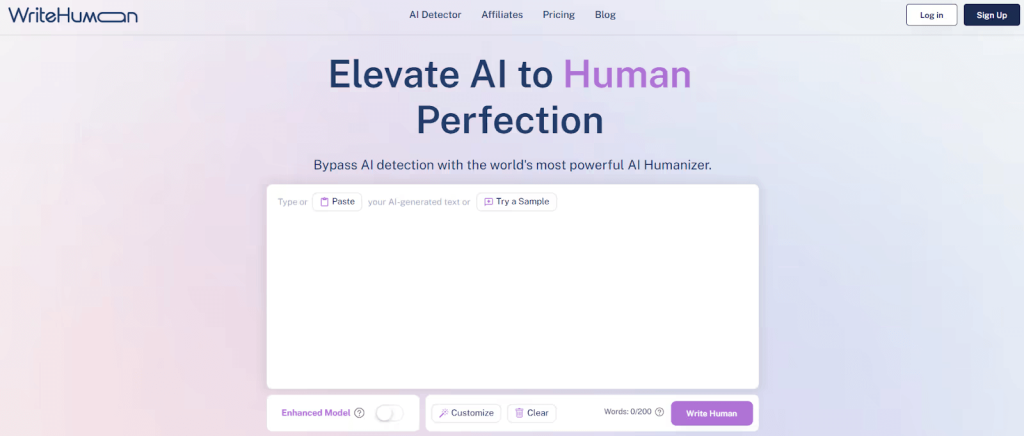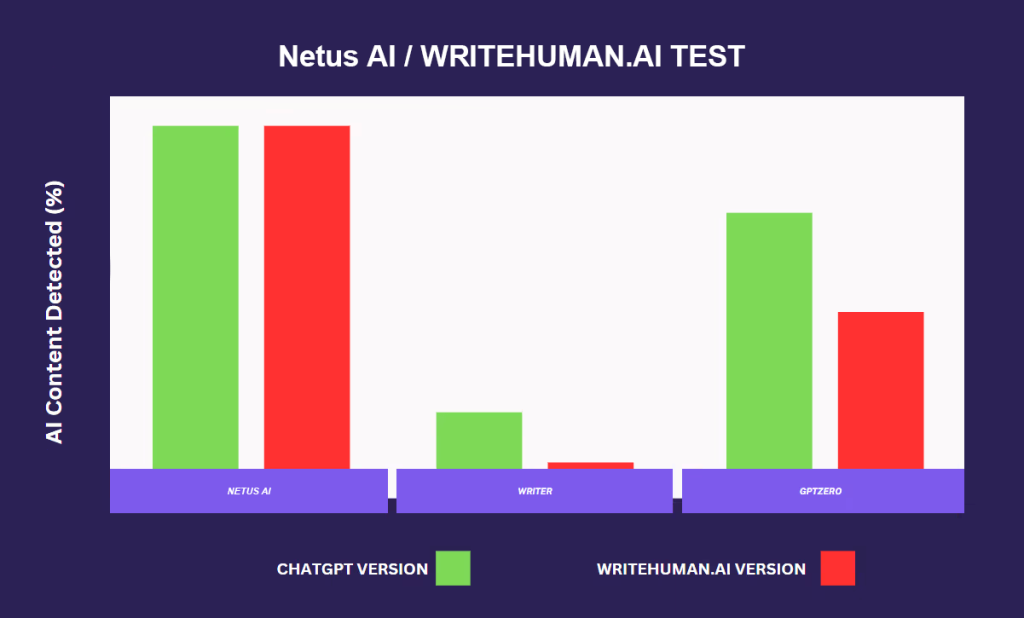WriteHuman.ai boldly claims to help AI-generated text sound more like human writing, making it harder for AI detection tools to identify. We decided to put this tool to the test and see if it lives up to the hype. Here’s what we discovered.

“Bypass AI detection with the world’s most powerful AI Humanizer..”This bold statement on WriteHuman.ai’s homepage sets high expectations. But does it deliver on this promise? With AI detection tools improving every day, bypassing them is no small feat. Many tools, like Rewritify, Twixify, and Humanize.io, have tried similar approaches. However, top-tier tools like Netus AI often reveal that these efforts fall short.
So, how does WriteHuman.ai stack up? Let’s dive in.
Let’s talk about a few things:
WriteHuman.ai is a tool designed to transform AI-generated writing into text that feels more natural and human-like. Its main promise? To help users bypass AI detection tools that identify content produced by artificial intelligence. With bold claims like being “the best” at humanizing AI text, WriteHuman.ai has attracted attention from bloggers, marketers, and professionals alike..
The platform highlights its ability to make AI-generated content appear authentic, offering a solution for those worried about detection. However, while the idea is appealing, it’s essential to scrutinize these claims. Early tests suggest that not all tools claiming to make AI content undetectable deliver consistent results, raising questions about their effectiveness.
Creating high-quality content can be a daunting and time-consuming task, especially when creativity runs dry or deadlines loom. That’s where tools like WriteHuman.ai come in.
AI-generated content offers a quick and effortless way to produce text, often requiring just a few clicks to generate paragraphs of information. This convenience is a major draw for bloggers, marketers, students, and businesses who want to save time and increase productivity. Tools like WriteHuman.ai build on this advantage by providing a solution to one major drawback of AI content: the risk of detection.
Many people are hesitant to use AI-written content because platforms like Google have policies against low-quality AI-generated material that violates their guidelines. These policies could lead to penalties, such as lower search rankings or reduced visibility. WriteHuman.ai offers a way to bridge the gap, allowing users to reap the benefits of AI while avoiding potential consequences by “humanizing” the text to make it less likely to be flagged.
This balance of convenience and safety is why tools like WriteHuman.ai are becoming increasingly popular.
At the heart of the matter is one key question:
Can WriteHuman.ai really trick AI detectors?
To find out, we conducted a straightforward experiment
The Experiment
We began by generating an article using ChatGPT, a well-known AI content creation tool. The article was then evaluated with three widely-used AI detection tools:
The results? Unsurprisingly, all three detectors flagged the article as AI-generated.
Next, we took the same article and ran it through WriteHuman.ai to “humanize” the content. This process aimed to make the text sound less robotic and more natural, addressing common patterns that AI detectors typically identify.
Finally, we checked the rewritten article using the same three AI detection tools to determine if there was a noticeable improvement and to explore the reasons behind any changes.
Here is our prompt:
To determine how effectively WriteHuman.ai can transform AI-generated content into human-like writing, we conducted an experiment using the following prompt:
“Write an informative article on the importance of maintaining good posture and how to choose the right chair to support it.”
The content focused on the significance of posture for health, common problems caused by poor posture, and practical tips for improvement, ending with advice on selecting the ideal chair for long-term well-being.
We used three popular AI detection tools – Netus AI, GPTZero, and Writer AI to assess the original ChatGPT-generated article and its version processed through WriteHuman.ai. Here’s what we found:
After testing WriteHuman.ai, we found it fell short of its promise, especially when assessed by advanced AI detection tools like Netus AI. Here’s why.

When we processed the AI-generated content through WriteHuman.ai, it introduced several issues:
These errors not only compromised the quality of the content but also confirmed that WriteHuman.ai struggles to make AI-generated text undetectable.
In simple terms, no, it doesn’t work effectively for creating undetectable AI-generated content. While it might slightly improve the text’s readability or reduce detection scores on some tools, it’s far from foolproof. This inconsistency makes it unreliable for users who need polished, authentic-looking content.
For the best results, it’s wise not to rely entirely on AI tools for content creation. Instead, use them as assistants to brainstorm ideas, outline drafts, or speed up repetitive tasks. The final touch: adding creativity, refining tone, and ensuring quality, should come from human effort. This combination of AI’s efficiency and human ingenuity is the key to producing unique, compelling content that stands out.
WriteHuman.ai sets out to solve a growing challenge: making AI-generated content indistinguishable from human writing. While it shows some potential, especially with tools like GPTZero and Writer AI, it struggles to deliver consistent results across all detection systems. Our experiment revealed that advanced detectors like Netus AI could still identify the content as AI-written, even after it was processed through WriteHuman.ai.
The tool’s limitations, including occasional grammar and spelling errors, further highlight the need for a balanced approach to content creation. AI tools like WriteHuman.ai may serve as helpful aids, but relying solely on them for undetectable, high-quality content is not advisable.
Instead, the best approach lies in combining the efficiency of AI tools with the creativity and insight that only humans can bring. For those seeking a reliable AI paraphraser or detector, Netus AI remains a standout choice, offering both robust paraphrasing capabilities and precise detection.
Ultimately, good content comes from thoughtful effort. Whether you’re writing from scratch or refining AI-generated text, the key to success is blending technology with a human touch for polished, engaging, and authentic results.
Is WriteHuman.ai free to use?
Yes, WriteHuman.ai offers a free trial, allowing users to process up to 200 words. After reaching this limit, you’ll need to subscribe to a paid plan to continue using the tool
How can I make my AI text hidden?
The most effective way to ensure your AI-generated text goes unnoticed is to minimize reliance on AI tools. Instead:
This blend of AI efficiency and human input reduces the chances of detection.
What is WriteHuman.ai?
WriteHuman.ai is an AI-powered tool designed to make AI-generated content sound more human. It markets itself as the “world’s strongest AI Humanizer,” promising to help users create natural-sounding text and bypass AI detection tools. While its claim is bold, the tool has shown mixed results in effectiveness during testing.
Through digital leadership we empower people to leverage the opportunities in global economy
@ 2024 Netus AI.